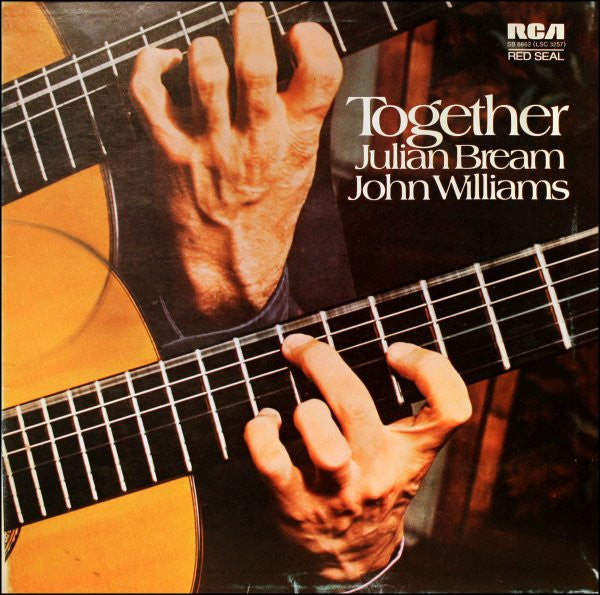Retro Revolution Records
Julian Bream & John Williams – Together -1972 - Classical Guitar (UK Import Vinyl)
Julian Bream & John Williams – Together -1972 - Classical Guitar (UK Import Vinyl)
Couldn't load pickup availability
Julian Bream & John Williams – Together -1972 - Classical Guitar
stock photo only
Label Condition (Out of 10) ~ 10
Vinyl Condition ~ (Out of 10)
Side 1 - 10
side 2 - 10
BIN # *37
Bream was born in Battersea, London and brought up in a musical environment in Hampton. Bream described his parents as both "conventional suburban", but in another way "very unusual". His father was a commercial artist, with an "extraordinary talent for drawing" and a "natural musician" according to Bream. Bream would lie under the piano in "ecstasy" when his father played. His mother, of Scottish descent, was a very beautiful woman who was often, according to Bream, "not always there" mentally and didn't like music, but was a warm-hearted person.[3] His grandmother owned a pub in Battersea, and Bream spent much time there during his youth. His father played jazz guitar and the young Bream was impressed by hearing the playing of Django Reinhardt; he would later call his dog "Django".[3]
Bream began his lifelong association with the guitar by strumming along on his father′s jazz guitar at an early age to dance music on the radio. He became frustrated with his lack of knowledge of harmony, so read instruction books by Eddie Lang to teach himself.[3] His father taught him the rudimentary basics. The president of the Philharmonic Society of Guitars, Dr Boris Perott, gave Bream further lessons, while his father became the society librarian, giving young Bream access to a large collection of rare music.
On his 11th birthday, Bream was given a small gut-strung Spanish guitar by his father. He became something of a child prodigy, at 12 winning a junior exhibition award for his piano playing, enabling him to study piano and composition at the Royal College of Music.[4] Aged 13, he made his debut guitar recital at Cheltenham on 17 February 1947;[5] in 1951, he debuted at Wigmore Hall.[4]
Leaving the RCM in 1952, Bream was called up into the army for national service.[4] He was originally drafted into the Pay Corps, but managed to sign up for the Royal Artillery Band after six months. This required him to be stationed in Woolwich, which allowed him to moonlight regularly in London with the guitar.[4]
After three years in the army, he took any musical jobs that came his way, including background music for radio plays and films. Commercial film, recording sessions and work for the BBC were important to Bream throughout the 1950s and the early 1960s.
He played part of a recital at the Wigmore Hall on the lute in 1952, and since has done much to bring music written for the instrument to light.
1960 saw the formation of the Julian Bream Consort, a period-instrument ensemble with Bream as lutenist. The consort led a great revival of interest in the music of the Elizabethan era.
Bream pursued a busy career playing around the world, his first European tours took place in 1954 and 1955, followed (beginning in 1958) by extensive touring in the Far East, India, Australia, the Pacific Islands and many other parts of the world. Bream performed for the Peabody Mason Concert series in Boston, first solo, in 1959, and later with the US debut of his Consort.[6]
In addition to master classes given in North America, Bream has conducted an international summer school in Wiltshire, England.
Tracklist
| Suite For Two Guitars | ||
| A1a | Corant I | |
| A1b | Alman | |
| A1c | Corant II | |
| Duo In G, Op. 34 | ||
| A2a | Largo | |
| A2b | Rondo | |
| L'encouragement, Op. 34 | ||
| A3a | Cantabile | |
| A3b | Theme And Variations | |
| A3c | Waltz | |
| B1 | Córdoba (Nocturne) From Spanish Songs, Op. 232 | |
| B2 | Goyescas: Intermezzo | |
| B3 | La Vida Breve: Spanish Dance No. 1 | |
| B4 | Pavane For A Dead Princess (Pavane Pour Une Infante Defunte) | |
Share


